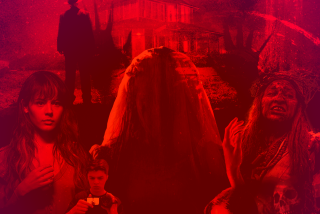Life’s a Charade in Mamet’s ‘Spanish Prisoner’ Puzzle
- Share via
When David Mamet directs, Ricky Jay is never far behind. The magician and sleight-of-hand artist has appeared in four of the playwright’s five films, including his latest, “The Spanish Prisoner.” More important than his work as an actor, however, is the way Jay’s presence serves as a thematic touchstone for a director who enjoys making the same kind of gleefully duplicitous film over and over again.
Starting with the aptly titled “House of Games” in 1987, Mamet as a director has been continually fascinated with elegantly mystifying cinematic puzzles. He uses dazzle and deception to build elaborate houses of cards that coldly toy with audience expectations the way playful cats fool around with mice trapped under their paws.
Mamet brings more than a decade’s worth of filmmaking experience to his latest project, and his skill as a director has improved considerably. “The Spanish Prisoner” is the smoothest and most convincing of Mamet’s elaborate charades and features intriguing performances by Steve Martin and Campbell Scott. But it shares with the writer-director’s earlier work a passion for self-consciously creating distance, for holding the audience at arm’s length, that remains a rarefied taste.
Given all that, the plot of “The Spanish Prisoner” (the title comes from the name of “the oldest confidence game on the books”) is especially difficult to describe. Set in a world where little turns out the way it first appears--”a small world chock-full of coincidences”--the film prides itself on being ahead of us just when we think we’ve figured it out. Everyone is suspect, even if we’re not exactly sure of what, and given the way masks drop simply to reveal still more masks, even revelations can be misleading.
“The Spanish Prisoner” opens on the mythical Caribbean island of St. Estephe, where Joe Ross (Scott) and his colleague George Lang (Jay) are flown down by their secretive boss, Mr. Klein (Ben Gazarra), to talk to a group of potential investors.
Blessed with youthful good looks, Joe is also a brilliant scientist who has come up with a process (no names, please) that will enable Klein’s Manhattan-based firm to control an unspecified global market and earn a spectacular amount of money.
Joe is a Boy Scout of sorts, trusting and naive, but not so much so that he is averse to making friends with the rich and successful Jimmy Dell (Martin), whom he meets on the island. Upon returning to New York, Joe and Jimmy strike up a friendship, and the wealthy older man advises Joe when he becomes fearful that Klein may not be planning to cut him in on the wealth his discovery is sure to create.
Joe makes another acquaintance on the island, Susan Ricci (Rebecca Pigeon), a new and very junior employee at Klein’s firm. Susan soon develops a gushing crush on Joe, a romantic development that he is not at all sure how to handle.
In placing these characters in a cold and ruthless world filled with “hush-hush developments,” where only fools trust anyone and figuring out who is duping who can literally be worth your life, Mamet makes extensive and idiosyncratic use of his own particular ideas of how dialogue should be recited.
While now-classic plays like “American Buffalo” and “Glengarry Glen Ross” show Mamet to be a master of intense, masculine wordplay, the most memorable movies he’s written, from “Wag the Dog” (directed by Barry Levinson) to “The Verdict” (directed by Sidney Lumet) to the film version of his own “Glengarry” (directed by James Foley), invariably come when someone else is in charge of the players.
That’s because Mamet demands that actors recite his words with distancing rhythms and cadences that make the conversations sound as if they took place on an alternative universe that parallels but does not connect to our own. This alienating verbal style puts peculiar emphasis on phrases like “You’re a real gent” and “I’m loyal and true and I’m not hard to look at,” emphasizing the artificiality of the situations and making any kind of involvement with the characters hard to imagine.
“The Spanish Prisoner” is more involving than Mamet’s previous puzzles at least, partially because protagonists Scott and Martin are good enough at handling the director’s dialogue to almost make these elaborate verbal charades a success. Martin especially taps sides of him we don’t often see as he oscillates between the sinister and the sincere.
What these men can’t always overcome is the film’s too-elaborate artifice, as well as specific moments where characters do completely implausible things only because the plot insists they do. The problem with “The Spanish Prisoner” is not so much, as one character asks, “If I told you this story, would you believe it?” as, “Even if you believed it, would you care?”
* MPAA rating: PG for thematic elements including tension, some violent images and brief language. Times guidelines: adult subject matter.
‘The Spanish Prisoner’
Campbell Scott: Joe Ross
Rebecca Pidgeon: Susan Ricci
Steve Martin: Jimmy Bell
Ben Gazarra: Klein
Ricky Jay: George Lang
Felicity Huffman: McCune
A Jean Doumanian production, released by Sony Pictures Classics. Director David Mamet. Producer Jean Doumanian. Executive producer J.E. Beaucaire. Screenplay David Mamet. Cinematographer Gabriel Beristain. Editor Barbara Tulliver. Costumes Susan Lyall. Music Carter Burwell. Production design Tim Galvin. Art director Kathleen Rosen. Set decorator Jessica Lanier. Running time: 1 hour, 52 minutes.
* In selected theaters.
More to Read
Only good movies
Get the Indie Focus newsletter, Mark Olsen's weekly guide to the world of cinema.
You may occasionally receive promotional content from the Los Angeles Times.











